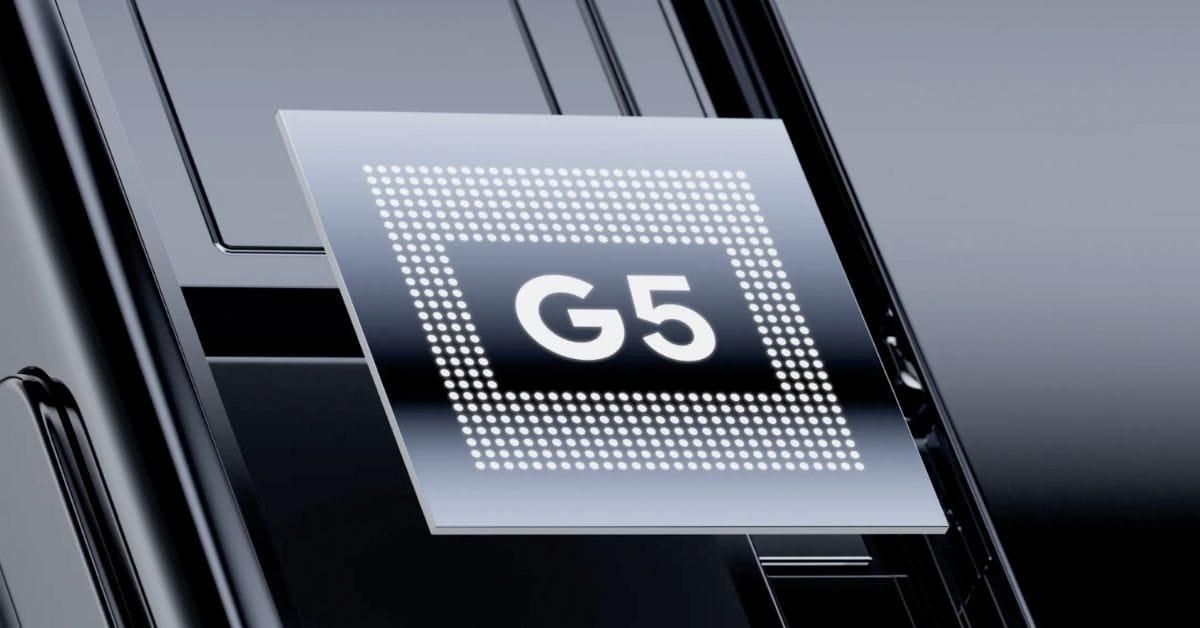- Tensor G5 marks Google’s shift to custom silicon: Built on TSMC’s 3nm process, it ends reliance on Samsung designs and introduces fully independent hardware development.
- Redesigned components inside Tensor G5: Includes a new CPU, possible Imagination GPU, upgraded TPU for AI, and custom ISP designed for Pixel photography improvements.
- Major efficiency and performance gains: Promises 34% faster CPU speeds, 60% stronger AI processing, and better thermal handling that extends Pixel 10 battery life.
- AI-driven user features expand: The TPU now supports real-time translation, conversation assistance, and larger context handling for on-device models without cloud reliance.
- Camera upgrades with custom ISP: Delivers sharper low-light video and advanced scene processing, powering features like 100× ProRes Zoom on the Pixel 10 Pro.
Google has officially launched the Pixel 10 lineup, and at the heart of every model is the Tensor G5. Unlike previous Tensor chips that were co-designed and manufactured with Samsung (often described as Exynos in disguise), the G5 is the first Tensor built entirely without Samsung’s involvement.
Fabricated by TSMC on its 3nm process, it represents Google’s most advanced custom-designed system-on-chip (SoC) yet.
It powers not only the Pixel 10 but also the Pixel 10 Pro, Pixel 10 Pro XL, and the foldable Pixel 10 Pro Fold. Here’s a closer look at what Tensor G5 is, what’s new inside the chip, and the big changes it brings compared to past generations.
Table of Contents
- What's Packed Inside Tensor G5?
- CPU: Faster and More Efficient
- GPU: A Big Change, But Still Behind
- TPU: The Real Star of the Show
- Custom ISP: Pixel’s Best Camera Yet
- Connectivity, Security, and Efficiency
- Key Highlights and Advantages of Tensor G5
- Tensor G5 Benchmarks
- Pixel 10 Series Devices Powered by Tensor G5
- Final Thoughts
What’s Packed Inside Tensor G5?
Every Tensor chip combines four main components: a CPU for general performance, a GPU for graphics and gaming, a TPU for AI tasks, and an ISP to handle photography and video. Together, they define what Google can offer uniquely on Pixel phones.
CPU: Faster and More Efficient
The Tensor G5’s CPU is Google’s biggest leap yet. It uses a tri-cluster setup:
- 1x Cortex-X4 core at 3.78 GHz for peak performance
- 5x Cortex-A725 cores at 3.05 GHz for heavy multitasking
- 2x Cortex-A520 cores at 2.25 GHz for efficiency
On average, the CPU is 34% faster than Tensor G4. Single-core performance is up by about 30%, and multi-core by 34–39%. In Geekbench 6, it scores around 2267 single-core and 5712 multi-core, with an AnTuTu score of roughly 1.45 million. That’s a big step up for Pixel phones, though it still trails Apple and Qualcomm in raw speed.
Here’s a quick table with the key CPU specs and benchmarks for easy reference:
| Core Configuration | Clock Speeds | Performance Gains | Benchmarks |
|---|---|---|---|
| 1x Cortex-X4 | 3.78 GHz | Peak single-core power | Geekbench 6: 2267 single-core |
| 5x Cortex-A725 | 3.05 GHz | Strong multitasking | Geekbench 6: 5712 multi-core |
| 2x Cortex-A520 | 2.25 GHz | Power efficiency | AnTuTu 10: ~1.45M |
GPU: A Big Change, But Still Behind
The GPU saw the biggest architectural shift. Google ditched Arm’s Mali graphics and went with Imagination Technologies’ PowerVR DXT-48-1536. On paper, it supports Vulkan 1.3, tile-based rendering, and even hardware ray tracing. But in reality, Google hasn’t enabled ray tracing yet, and performance has been disappointing so far.
In benchmarks, Tensor G5’s GPU scores ~490K on AnTuTu and just 3700–3800 on Geekbench Compute, which is lower than Tensor G4’s GPU and miles behind Snapdragon 8 Gen 3. Reports suggest outdated drivers and aggressive power limits are holding it back. The upside? It runs cool and stable, so casual games are fine. But if you’re into heavy gaming, Snapdragon or Apple chips still win easily.
Here’s a quick table with the key GPU specs and benchmarks for easy reference:
| GPU Architecture | Clock Speed | Features | Benchmarks | Notes |
| PowerVR DXT-48-1536 | Up to 1.1 GHz | Vulkan 1.3, tile-based rendering, hardware ray tracing (not enabled) | AnTuTu GPU: ~490K, Geekbench Compute: ~3700–3800 | Runs cool and stable, but lags behind rivals |
TPU: The Real Star of the Show
Where Google shines is AI, and Tensor G5 doubles down with its 4th-generation TPU. It’s up to 60% more powerful, runs Gemini Nano on-device, and delivers 2.6x faster AI model speed with 2x better efficiency. That means live translation with almost no delay, instant voice transcription, smarter suggestions, and advanced photo editing all happen right on your phone—without sending data to the cloud.
Google even built a new Matformer architecture, letting the TPU handle models with up to 8 billion parameters by smartly using both RAM and flash storage. In practice, that allows Pixel 10 phones to run up to 20 on-device AI tasks at launch, from generative image editing to contextual screenshots. More AI, more privacy, less battery drain.
Here’s a quick table with the key TPU specs and capabilities for easy reference:
| TPU Generation | Performance Gains | Key Features | AI Tasks Supported |
| 4th-gen TPU | 60% faster, 2x more efficient | Runs Gemini Nano on-device, Matformer architecture | Up to 20 on-device AI tasks, models up to 8B parameters |
Custom ISP: Pixel’s Best Camera Yet
For years, Google relied on Samsung-built ISPs with its own tweaks. Tensor G5 finally introduces a fully Google-designed ISP, and it transforms the Pixel 10 camera system.
It brings instant HDR+, default 10-bit video recording, and advanced motion deblur. Low-light photography gets clearer with improved Night Sight, and Real Tone captures more accurate skin tones. New features like Add Me, Auto Best Take, and Pro Res Zoom (up to 100x digital zoom) push Pixel photography even further.
Security is part of the upgrade too—the ISP supports C2PA Content Credentials, embedding digital signatures in images and videos so authenticity can be verified. In short, photos are sharper, faster, smarter, and more secure than ever.
Here’s a quick table with the key ISP specs and features for easy reference:
| ISP Design | Key Features | Video Capabilities | Security |
| Fully Google-designed custom ISP | Instant HDR+, motion deblur, Night Sight, Real Tone, Add Me, Auto Best Take, Pro Res Zoom (up to 100x) | Default 10-bit video (1080p, 4K30) | C2PA Content Credentials for image authenticity |
Connectivity, Security, and Efficiency
Tensor G5 also brings:
- A custom 5G modem with faster, more stable connections and global carrier support
- Wi-Fi 7 and Bluetooth 5.4 for modern wireless
- An integrated Titan security chip for stronger protection
- Up to 25% better battery life than Tensor G4 phones, with less heat and throttling
These changes make the Pixel 10 lineup not just smarter, but also more reliable for everyday tasks.
Key Highlights and Advantages of Tensor G5
Before diving deep, here’s what makes Tensor G5 stand out compared to its predecessors:
1. Shift to TSMC for Better Heat Management and Efficiency
Fabricated on TSMC’s cutting-edge 3nm process, Tensor G5 packs more transistors into a smaller space, boosting both efficiency and performance.
This shift is significant: earlier Tensor chips were built on Samsung’s nodes and often criticized for heating and efficiency issues. By moving production to TSMC, Google is following in the footsteps of Apple and Qualcomm, aiming for better yields, power savings, and more consistent thermal performance. In theory, this should help Pixels run cooler, last longer on a charge, and sustain performance under heavy workloads.
2. Impressive Performance Boosts
Tensor G5 delivers major leaps across the board. The CPU is 34% faster than before, so apps open quicker and multitasking feels smoother.
The TPU, which handles AI, is 60% stronger, meaning it can run advanced models on-device without slowing down. Gemini Nano, Google’s lightweight AI model, runs 2.6× faster while using half the power, so features like voice translation or contextual suggestions happen almost instantly.
Compared to last year’s Tensor G4, these numbers translate into a phone that feels more responsive in everyday use, handles demanding apps better, and processes AI-driven tasks with far less lag or battery drain.
3. AI Powerhouse
AI is where Tensor G5 really shines. The upgraded TPU is 60% more powerful, enabling it to run Gemini Nano 2.6× faster and twice as efficiently as before. This allows for real-time AI tasks that were previously too demanding, like:
- Magic Cue for contextual suggestions in conversations
- Call Notes with automatic action items
- A Personal Journal app powered by on-device generative AI
- Voice Translation that preserves your tone and voice with just a few seconds of training
Tensor G5 also supports a 32,000-token context window (up from 12,000), meaning it can handle the equivalent of 100 screenshots or a month’s worth of emails in one go. Techniques like the Transformer-based Matformer architecture and Per-Layer Embedding help large models run efficiently on mobile hardware.
Related: Here are all the new AI features on Pixel 10 phones.
4. Superior Camera Performance
Pixel phones are best known for their cameras, and Tensor G5 introduces Google’s first fully custom Image Signal Processor (ISP). This ISP works with the CPU, TPU, and DSP to deliver major gains:
- Sharper low-light video with motion deblur
- 10-bit HDR video by default in 1080p and 4K30
- More accurate Real Tone improvements for diverse skin tones
- Advanced scene segmentation that understands details like eyes, lips, and skin for better portraits
Perhaps the most striking upgrade is 100× ProRes Zoom on the Pixel 10 Pro models, powered by a nearly 1-billion-parameter AI model running directly on-device. For perspective, the Pixel 9’s zoom model had only a few million parameters.
5. Battery and Thermal Gains
Despite all this power, Google promises over 30 hours of battery life across the Pixel 10 series. Larger batteries play a role, but so does the more efficient 3nm process. Google has also added stronger thermal controls, with vapor chamber cooling in Pro models and graphite-based solutions in the standard Pixel 10. This should help prevent overheating, a long-time issue with previous Tensors.
Connectivity remains largely unchanged, with Google carrying over the Exynos 5400 modem introduced last year — now with further software optimizations.
6. Architectural Overhaul
Tensor G5 also marks a big architectural shift. Google swapped the old Arm Mali GPU for a new Imagination Technologies IMG GPU, which should deliver smoother graphics and more modern rendering support. For video, it dropped its in-house BigWave codec in favor of a proven Chips&Media WAVE 677DV engine that handles formats like AV1, HEVC, and VP9 up to 4K120.
The chip also integrates licensed IP from Synopsys and VeriSilicon for things like memory controllers, display handling, and interface blocks. These off-the-shelf parts allow Google to focus on custom areas while ensuring reliability.
At the same time, Google kept its own custom blocks: the EdgeTPU for AI, the GXP DSP, and its fully custom ISP. This makes Tensor G5 a hybrid design, mixing Google’s unique silicon with licensed components to balance innovation with stability.
Tensor G5 Benchmarks
Benchmarks aren’t the whole story, but they give us a good idea of how Google’s new chip stacks up. The Tensor G5 shows clear improvements over last year’s Tensor G4 and finally feels like a flagship SoC, though it still doesn’t beat Qualcomm or Apple when it comes to raw power.
Geekbench 6 Performance
On Geekbench 6, the Tensor G5 scores between 2,267–2,296 in single-core and 6,034–6,203 in multi-core tests. That’s about a 20–25% boost in single-core and 40–46% jump in multi-core compared to the Tensor G4 and Pixel 9 series.
Everyday performance and multitasking feel smoother, but compared head-to-head, it lags behind the Snapdragon 8 Elite, which scores well above 3,000 single-core and 9,000 multi-core. Apple’s A18 Pro also stays comfortably ahead.
| SoC | Single-Core | Multi-Core |
|---|---|---|
| Tensor G5 | 2,267–2,296 | 6,034–6,203 |
| Snapdragon 8 Elite | ~3,033–3,831 | ~9,271–11,525 |
| Pixel 9 Pro XL | ~1,889 | ~4,247 |
Also Read: Apple A19 vs Google Tensor G5: Specs and Real Benchmarks
Antutu 10 Results
On Antutu, the Tensor G5 lands between 1.17 million and 1.29 million points. It’s a big leap over the Tensor G4 and competitive with last year’s Snapdragon 8 Gen 3, but it falls short of the Snapdragon 8 Elite, which sits comfortably above 2.2 million.
Looking deeper:
- CPU scores reach ~415K–457K, matching mid-flagship chips like Snapdragon 8s Gen 3.
- GPU scores hit ~367K–490K, which is lower than expected — closer to older Snapdragon 8 Gen 1 levels. That means gaming at ultra settings isn’t this chip’s strongest suit.
- Memory and UX scores are decent, showing Google focused on efficiency and smooth usage rather than peak gaming numbers.
| Test Component | Typical Score |
|---|---|
| Total Score | 1,173,221–1,291,252 |
| CPU | ~415,848–457,073 |
| GPU | ~367,206–490,471 |
| Memory | ~222,069–321,568 |
| UX | ~208,988–312,012 |
3DMark Wild Life Extreme
When it comes to graphics stress tests, the story is mixed. The Tensor G5 scores around 3,122–3,254 in 3DMark Wild Life Extreme, with frame rates just under 20FPS. That’s a 24–27% improvement over Tensor G4, but still about half the performance of Snapdragon 8 Elite.
The surprising win here is stability. While rivals throttle hard, the Tensor G5 keeps performance steady at around 95% stability. In practice, that means the Pixel 10 series can handle long gaming sessions without overheating, even if it can’t push the highest graphics settings like Qualcomm or Apple chips.
| Device / SoC | Best Loop | Worst Loop | Stability | FPS |
|---|---|---|---|---|
| Pixel 10 Pro XL (G5) | 3,252 | 3,094 | 95.1% | <20 |
| Pixel 9 Pro XL (G4) | 2,631 | 1,679 | 63.8% | ~15–16 |
| Galaxy S25 Ultra | 6,762* | 3,365* | 49.8%* | 38.3* |
| iPhone 16 Pro Max | 4,927* | 3,223* | 65.5%* | 28–30* |
*Snapdragon 8 Elite / A18 Pro competitor scores for context
Pixel 10 Series Devices Powered by Tensor G5
Tensor G5 brings consistency across the Pixel 10 lineup, but each device adds its own flavor.
- Pixel 10: 6.3” OLED, triple-camera system (48MP + 13MP ultrawide + 10.8MP telephoto), 12GB RAM, 4,970mAh battery, and 30W wired charging.
- Pixel 10 Pro / Pro XL: Higher-resolution LTPO OLED panels, triple 50MP + 48MP + 48MP cameras, 8K video recording, up to 1TB storage, 16GB RAM. Pro XL adds a 6.8” display, 45W wired charging, and 25W wireless via Qi2.
- Pixel 10 Pro Fold: 6.4” outer + 8” inner OLED displays, IP68 water and dust resistance (a foldable first), triple cameras, 5,015mAh battery, Tensor G5 with 16GB RAM.
- All models: Qi2 magnetic charging, Titan M2 security chip, Android 16 out of the box, and seven years of OS/security updates.
Final Thoughts
Tensor G5 isn’t about chasing benchmarks. Instead, it cements Google’s vision of AI-first smartphones by combining more efficient hardware with deeply integrated machine learning features. With stronger cameras, smarter AI, and better efficiency, the Pixel 10 lineup shows how Google is finally stepping into maturity with its own silicon.
In short, Tensor G5 is the backbone of Google’s most ambitious Pixel phones yet – A chip designed not just to compete on raw specs, but to deliver AI-driven experiences that feel genuinely useful every day.
In case you missed:








